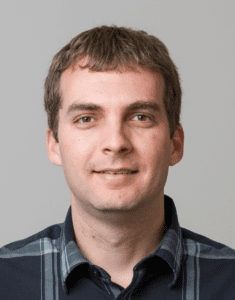Inside AJHG: A Chat with Mitchell Machiela
Each month, the editors of The American Journal of Human Genetics interview an author of a recently published paper. This month we check in with Mitchell (@mitchiela) to discuss his recent paper “Targeted long-read sequencing of the Ewing sarcoma 6p25.1 susceptibility locus identifies germline-somatic interactions with EWSR1-FLI1 binding”.

KS: What motivated you to start working on this project?
MM: Our main motivation for this study was to better understand how germline genetic variation in the 6p25.1 Ewing sarcoma (EwS) susceptibility locus contributes to EwS risk. Specifically, based on evidence from a prior investigation of the 10q21.3 EwS susceptibility locus showing a relationship with a nearby GGAA microsatellite, we sought to characterize germline variation in and around a GGAA microsatellite at the 6p25.1 locus to better understand how it may interact with EWSR1-FLI1 binding. EWSR1-FLI1 translocations are common in EwS and bind better to longer GGAA microsatellites promoting dysregulation of nearby genes.
KS: What about this paper/project most excites you?
MM: A key feature of this study that excites me is the ability to test long-read sequencing as an approach to characterize EwS susceptibility loci. We chose this sequencing approach as it enables us to sequence the GGAA microsatellites and determine which alleles an individual carries. In addition, the long reads allow for direct phasing of the GGAA microsatellite alleles to determine which are in linkage disequilibrium with EwS GWAS-associated risk variants.
KS: Thinking about the bigger picture, what implications do you see from this work for the larger human genetics community?
MM: This study has implications for the larger genetics community as it provides a remarkable example of how germline variation interacts with a somatically acquired fusion to promote EwS sarcomagenesis. It is likely such germline-somatic interactions exist for other diseases as well. Integrative genomic analyses that include data on both germline and somatic variation are critical for disentangling genetic risk for complex diseases such as cancer.
KS: What advice do you have for trainees/young scientists?
MM: Learn as much as you can about all things genomics. Most high-impact studies have a combination of functional work, population genetics, and bioinformatics. A strong skillset spanning many of these disciplines will help you excel at leading integrative genomics studies that unravel novel genetic insights.
KS: And for fun, tell us something about your life outside of the lab.
MM: We are looking into raising chickens in our backyard. Apparently, they have a lot of character and would be an interesting experience for our kids to help raise. While I am looking forward to fresh eggs from our hens, I suspect our “free” eggs will still cost more than the sharply increasing egg prices at the grocery store after factoring in the costs of raising the hens.
